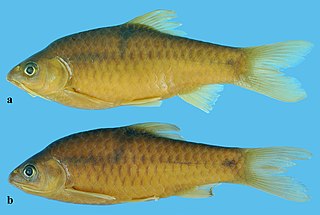
Puntius is a genus of small freshwater fish in the family Cyprinidae native to South Asia and Mainland Southeast Asia, as well as Taiwan.

Rasbora is a genus of fish in the family Cyprinidae. They are native to freshwater habitats in South and [Pakistan [Southeast Asia]], as well as southeast China. A single species, R. gerlachi, is only known from an old specimen that reputedly originated from Africa (Cameroon), but this locality is considered doubtful. They are small, up to 17 cm (6.7 in) long, although most species do not surpass 10 cm (4 in) and many have a dark horizontal stripe.

The harlequin rasbora is a small fish in the family Cyprinidae. The species became an instant favorite among aquarists after its introduction in the early 1900s and is the best known and most widely kept species among the rasboras. In 1935, an image of a trio of harlequin rasboras, stamped in 14k gold, would grace the cover of the first edition of William T. Innes's classic Exotic Aquarium Fishes and would remain so through all 19 editions.

Barbonymus is a ray-finned fish genus in the family Cyprinidae, containing some barb species. The genus was only established in 1999, with the tinfoil barb as type species; thus, these fish are sometimes collectively called tinfoils. The new genus was established in recognition of the fact that some large Asian "barbs", formerly rather indiscriminately lumped in Barbus, Barbodes and Puntius, form a distinct evolutionary lineage.

Barbodes binotatus, commonly known as the spotted barb or common barb, is a tropical species of cyprinid fish endemic to Java, Indonesia.

Barbodes lateristriga, the spanner barb or T-barb, is a species of cyprinid fish native to the Malay Peninsula and the island of Borneo. It can reach a length of 18 centimetres (7.1 in) TL. This species can also be found in the aquarium trade.

Sundadanio axelrodi is a danionin in the family Cyprinidae, with origin from Borneo, Bangka, and Sumatra. Originally described as a rasbora, Rasbora axelrodi, this tiny species was later deemed to be more closely related to the danios but not enough to be moved into the genus Danio. Sundadanio axelrodi reaches a maximum size of 1.7 cm. Sundadanio was considered monotypic until the genus was reassessed by Conway, Kottelat and Tan in 2011.

Barbodes is a genus of small to medium-sized cyprinid fish native to tropical Asia. The majority of the species are from Southeast Asia. Many species are threatened and some from the Philippines are already extinct. A survey carried out in 1992 only found three of the endemic Barbodes species, and only two were found in 2008. Several members of this genus were formerly included in Puntius.

Auriglobus is a genus of freshwater pufferfishes native to Southeast Asia. They generally resemble Chonerhinos, but are considerably smaller, only reaching up to 13 cm (5.1 in) in length, and are more strongly associated with freshwater. The different Auriglobus species are very similar in appearance — greenish-golden or yellowish-golden above and pale below — but can be separated by morphometrics and meristics. Until 1999, the Auriglobus species were included in Chonerhinos.

Chonerhinos naritus, the bronze pufferfish or yellow pufferfish, is a species of pufferfish native to Southeast Asia, where mainly found in estuarine and coastal habitats. This species grows to a length of 28.5 centimetres (11.2 in) TL, but otherwise it generally resembles the smaller and more strictly freshwater Auriglobus pufferfish. This predatory species feeds on other fish, crustaceans and snails.

Barbodes montanoi is a species of cyprinid fish endemic to the island of Mindanao, the Philippines. It is commonly known as pait, pait-pait, or paitan, along with other native Barbodes species. This species can reach a length of 9 centimetres (3.5 in) TL. It is silvery greenish-gray in color and is characterized by a body pattern of two to six black dots or dashes. The fins are yellowish to reddish in color. The species is named after the French naturalist and explorer Joseph Montano.

Barbodes rhombeus is a species of cyprinid fish native to the Southeast Asian countries of Cambodia, Laos and Thailand where it inhabits clear hill streams. This species can reach a length of 6.5 centimetres (2.6 in) SL.
Rasbora cephalotaenia is a species of ray-finned fish in the genus Rasbora. It is found on the Malay Peninsula and Indonesia.
The yellow rasbora is a species of ray-finned fish in the genus Rasbora from Southeast Asia. It is a primarily freshwater fish originally from Java island in Indonesia. It is known as the Wader pari fish in the Indonesian language. In addition, it was a protein source for the local community during the old days.
Paul Georg Egmont Duncker was a German ichthyologist.
Rasbora vulgaris is a species of ray-finned fish in the genus Rasbora. It is a member of the R. paviana-subgroup, which comprises of five species from Indochina and the Malay Peninsula
Barbodes palavanensis is a species of freshwater ray-finned fish from the carp and minnow family, Cyprinidae which is found in the Philippines. It has been considered to be conspecific with the widespread spotted barb which is found throughout mainland south-east Asia and the Malay Archipelago. It was recorded as being abundant in two streams on the island of Palawan, alongside the newly described endemic goby, Stiphodon palavanensis and the cyprinid Rasbora everetti.
Barbodes xouthos is a species of freshwater ray-finned fish from the carp and minnow family Cyprinidae. It has only been recorded from Brunei on the island of Borneo. It has an unusual pattern on its body consisting of a plain brown body with faint reticulations.

Barbodes zakariaismaili, or Zakaria's barb, is a newly described species of cyprinid fish as of 2021. The species is native to Malaysia, where it is found in foothills and lowland streams with clear water in the southern Malay Peninsula. The species has very little to no significant commercial value.












